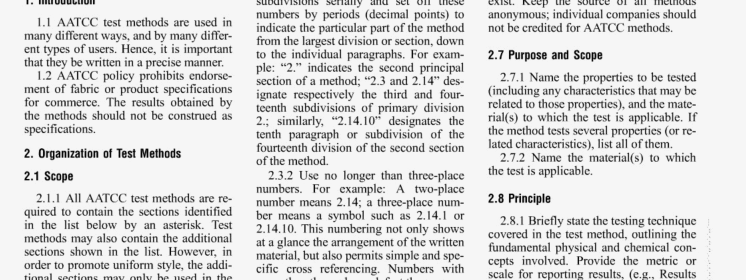AATCC Style Guide for Writing Test Methods

AATCC STYLE GUIDE-2017 pdf free.AATCC Style Guide for Writing Test Methods.
17.1 In the case of arbitrary grades or classifications and of scores for ranked data, the observations may have such a complex nonlinear relationship that meaningful transformations may not be practicable. If this is , use the text illustrated as XX.l and XX.2 as a guide in giving a subjective basis for evaluating the precision of test results:
XX.1 Precision and Bias
111.1 Inlerlaboratorv Thst Data4— An interlaboratory lest was run in i QXX in which randomly drawn samples of two materials were tested in each of five laboratories. Each laboratory used two operators, each of whom tested tour specimens of each material. Calculation of components of variance was thought to be inappropriate due to the restricted and discontinuous rating scales, the non-linear relationships between the rating scales and color difference units, and the increased variability in color ditierence units as the true value of the ratings decrease.
111.2 Prtcision Based on the observations described in Ill. I and on general practice in the trade, a lot or consignments is generally considered as having a rating that is significantly worse than a specified value when a specimen from the lot or consignment has a rating for (insert here the name of the property) that is more than one-half step below the specified rating on the Gray Scale for Color Change.
2.22.11 New or current methods which do not generate data, should contain the following statement: A precision statemcnt is not applicable bccausc data arc not gencrated by this test method. An altcrnativc for combined Precision and Bias Statement: Precision and Bias statements arc not applicable because data are not generated by this test method.
2.22.12 Methods which state only within-Iuhøraiorv precision, add the following as a separate statement
laboratory precision has not been established for this test method. Until such precision information is available. users of the method should usc standard statistical techniques in making any comparison of test results for between-laboratory averages (see 122.13).
2.22.13 Analysis of variance or i-tests may be used to compare averages. Sec any standard statistical text for more information.
2.22.14 Any new AATCC lest method that produces data shall contain, as a mmimnum. a statement of single operator precision when first submitted to committee and T(’R ballots, but full conformance with 2.22.4 and 2.22.7 arc encouraged.
2.22.15 At its first five year reaflirmation, any AATCi’ test method that produces data shall be brought into full conformance with 2.224 and 2.22.7 prior to submission to committee and T(R ballots.
2.22.16 It is the policy of AATCC that no longstanding test methods will be dropped due to the lack of a precision statement. The research committee responsible for any longstanding AATCC test method which is not currently in conformance with the provisions of 2.22.4 and 2.22.7, should endeavor to develop as a minimum, a statement of single operator precision prior to being submitted to committee and TCR ballot for reaffinnation, but full conformance is encouraged.
2.22.17 At its next fivc ycar rcaffinnation. the research committee responsible for any longstanding tcst method, which was pi-cviously rcaffirmcd undcr 2.22.16, should cndcavor to bring thc method into full conformance with 2.22.4 and 2.22.7 prior to being submitted to committee and TUR ballot for reaffirmation.
2.22.1 X Teti methods that do not contain a precision statement shall contain the following statements. Precision for this test method has no been established, Until a prccision statement is gcncratcd for this test method, caution should be used when testing materials with this method. In most cases the use of standard statistical techniques in making any comparisons of test reult for either withinlaboratory or between-laborator averages have been found to be generally accepted.
2.22.19 Research committees arc rcsponsiblc for timely conformance to precision and bias policy. initiation of intcrlaboratory studies, writing required precision and bias statcmcnts. u-acking thc need for revisions, and keeping to thc reaffirmation timetables contained in
2.22,14.
2.22.2() In any AATCC test method that produces data in which more than one testing option is allowed, a precision statement based on the most used option satisfies the requirement. A committee may include precision for the other options, and is encouraged to do so, especially single laboratory precision for each option available.
2.22.21 Research cu,n,nittees should continue to work to develop precision data as described in 2.22,4.
2.22.22 Precision Statement Format. The precision statement included in a test method must contain three basic sections:
(I) a brief description of the testing plan from which the data set was derived. citing the nwnber of materials tested. the number of laboratories participating, the number of operators per laboratory. the number of tests per operator. and any other pertinent information; (2) a listing of the components of variance derived from the data set; and (3) a listing of the precision parameters calculated from the components of variance, usually in the form of critical differences, or confidence intervals. (see ASTM D2906)
2.23 Bias
2.23.1 Bius A statement on bias furnishes guidelines as to whether the test method can be used when comparisons with accepted reference values are to be made. (For an extended discussion, see ASTM D2906, Statements on Precision and Bias for Textiles.) If the bias is known, the method can be modified to include a con’ection for the bias, and thus the corrected method would be without known bias.
2.23.2 If bias varies with the test level. describe the bias.AATCC STYLE GUIDE pdf download.AATCC Style Guide for Writing Test Methods